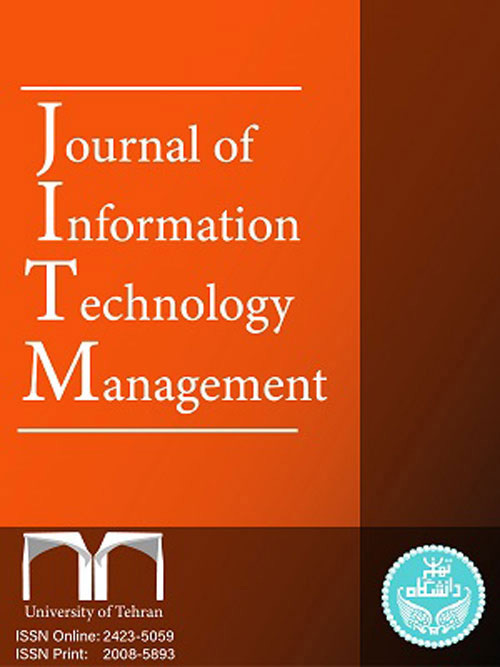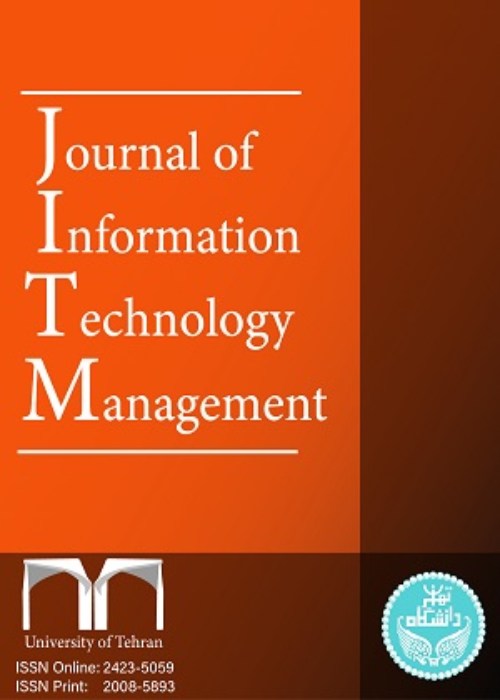فهرست مطالب

Journal of Information Technology Management
Volume:11 Issue: 2, Spring 2019
- تاریخ انتشار: 1398/03/13
- تعداد عناوین: 6
-
-
Pages 1-42
The ability of now-casting and eventuality is the most crucial and vital achievement of big data analytics in the area of policy-making. To recognize the trends and to render a real image of the current condition and alarming immediate indicators, the significance and the specific positions of big data in policy-making are undeniable. Moreover, the requirement for policy-making institutions to produce a structured model based on big data analytics for now-casting and eventuality of predictive policies is growing rapidly. The literature review demonstrates that a comprehensive model to assist policy-making institutions by providing all components and indicators in now-casting of predictive policies based on big data analytics is not devised yet. The presentation of the model is the main finding of this research. This research aims to provide a comprehensive model of now-casting and eventuality of predictive policies based on big data analytics for policy-making institutions. The research findings indicate that the dimensions of the comprehensive model include: the alignment of now-casting strategies and the big data analytics’ architecture, now-casting ecosystem, now-casting data resources, now-casting analytics, now-casting model and now-casting skill. The results of using the model were analyzed and the recommendations were presented.
Keywords: Big data analytics, Now-casting, Comprehensive model, Policy-making Institution -
Pages 43-58
Brand community interactions and online customer support have become major platforms of brand sentiment strengthening and loyalty creation. Rapid brand responses to each customer request though inbound tweets in twitter and taking proper actions to cover the needs of customers are the key elements of positive brand sentiment creation and product or service initiative management in the realm of intense competition. In this research, there has been an attempt to collect near three million tweets of inbound customer requests and outbound brand responses of international enterprises for the purpose of brand sentiment analysis. The steps of CRISP-DM have been chosen as the reference guide for business and data understanding, data preparation, text mining, validation of results as well as the final discussion and contribution. A rich phase of text pre-processing has been conducted and various algorithms of sentiment analysis were applied for the purpose of achieving the most significant analytical conclusions over the sentiment trends. The findings have shown that the sentiment of customers toward a brand is significantly correlated with the proper response of brands to the brand community over social media as well as providing the customers with a deep feeling of reciprocal understanding of their needs in a mid-to-long range planning.
Keywords: Brand community, Sentiment analysis, Text mining, Twitter, Customer support -
Pages 59-78
Recommender systems are important tools for users to identify their preferred items and for businesses to improve their products and services. In recent years, the use of online services for selection and reservation of hotels have witnessed a booming growth. Customer’ reviews have replaced the word of mouth marketing, but searching hotels based on user priorities is more time-consuming. This study is aimed at designing a recommender system based on the explicit and implicit preferences of the customers in order to increase prediction’s accuracy. In this study, we have combined sentiment analysis with the Collaborative Filtering (CF) based on deep learning for user groups in order to increase system accuracy. The proposed system uses Natural Language Processing (NLP) and supervised classification approach to analyze sentiments and extract implicit features. In order to design the recommender system, the Singular Value Decomposition (SVD) was used to improve scalability. The results show that our proposed method improves CF performance.
Keywords: Grouping recommender systems, Sentiment analysis, Deep learning, Singular Value Decomposition (SVD -
Pages 79-110
Recently, significant technological changes, greater customer demand and the rise of new business models have triggered a rapid increase in electronic service (e-service) innovations. Now, innovation in the provision of e-services has become one of the priorities of managers in order to gain a competitive advantage. However, few studies so far have explored the determinant factors needed in the organization in order to innovate and implement e-services. The purpose of this study is to provide a comprehensive framework that integrates the multiple factors of e-service innovation. Using the qualitative meta-synthesis research method and after a systematic review of the literature and examination of 61 articles, all factors needed for innovation in e-services have been identified and classified in 4 capabilities, 9 concepts, and 30 codes. The results show that e-service innovation depends on networking, informational, operational and supporting, and strategic capabilities. These capabilities create the required platform for innovation in e-services in the organization. This study contributes to current e-service researches by offering theoretical advances related to innovation in e-services. Furthermore, the capabilities, concepts, and codes identified in this study would be useful as a comprehensive conceptual framework for developers of e-service innovation to plan and evaluate their related initiatives.
Keywords: Electronic service, E-service innovations, Dynamic capability view, Meta-synthesis -
Pages 111-128
Persian language is one of the most widely used languages in the Web environment. Hence, the Persian Web includes invaluable information that is required to be retrieved effectively. Similar to other languages, ranking algorithms for the Persian Web content, deal with different challenges, such as applicability issues in real-world situations as well as the lack of user modeling. CF-Rank, as a recently proposed learning to rank data, aims to deal with such issues by the classifier fusion idea. CF-Rank generates a few click-through features, which provide a compact representation of a given primitive dataset. By constructing the primitive classifiers on each category of click-through features and aggregating their decisions by the use of information fusion techniques, CF-Rank has become a successful ranking algorithm in English datasets. In this paper, CF-Rank is customized for the Persian Web content. Evaluation results of this algorithm on the dotIR dataset indicate that the customized CF-Rank outperforms baseline rankings. Especially, the improvement is more noticeable at the top of ranked lists, which are observed most of the time by the Web users. According to the NDCG@1 and MAP evaluation criteria, comparing the CF-Rank with the preeminent baseline algorithm on the dotIR dataset indicates an improvement of 30 percent and 16.5 percent, respectively.
Keywords: Learning to rank, Persian language, CF-Rank algorithm, dotIR dataset, Information fusion -
Pages 129-143
The purpose of this research is to explore the social media trend in communication in Kuwait by utilizing the technology acceptance model. Social media has been gaining extraordinary adoption in past years that requires further investigation into user’s adoption habits, the various kinds of social media, and its effect on their perceived usefulness and ease of use of social media. The study consists of a total of 250 participants that were asked to complete a questionnaire in a random sample. Important findings indicate that the highest number of participants uses Facebook, and the second highest number of participants use Twitter. In terms of usage habits, the highest number of participants uses social media for chatting and connecting with family and friends. The second highest number of participants uses social media for reading posts. In terms of perceived usefulness, the highest numbers of participants perceive social media as ‘usefulness’, and the second highest numbers of participants feel that ‘social media is faster’. In terms of perceived ease of use the highest numbers of participants feel that social media is an easy way to communicate, and the second highest numbers of participants feel that social media does not require a lot of effort. In terms of gender it has been evident that females feel higher perceived usefulness and perceived ease of use of social media than males. The study bears theoretical and practical implications that show TAM can be successfully applied to examine social media in the context of Kuwait population. Furthermore, results of this study can be further generalized to neighboring GCC countries as they share similar geographic, economic, cultural, and financial factors.
Keywords: Social media, Technology acceptance model (TAM), Perceived ease of use (PEOU), Perceived usefulness (PU), Experience, Intention to adopt


